An Online Scientific Twitter World: Social Network Analysis of #ScienceTwitter, #SciComm, and #AcademicTwitter
Abstract
1. Introduction
2. Conceptual Framework
3. Background
3.1. Science Communication on Twitter
3.2. Research Questions
- RQ1: Who is involved in the affinity space of #ScienceTwitter, #SciComm, and #AcademicTwitter?
- RQ2: How is scientific information contributed and distributed in this affinity space?
- RQ3: How is the flow of information in the Twitter network influenced and controlled by different types of users?
4. Materials and Methods
4.1. Data Collection
4.2. Data Coding
4.3. Data Analysis
5. Results
5.1. Social Network Analysis
5.2. User Analysis
5.2.1. Scientists and Educators Held the Sources of Information and Public Disseminated Information
5.2.2. Scientists and Educators Connected Other Users
5.2.3. Public and Education Users Spread Information
5.2.4. Public and Education Users Had Many Influential Connections
6. Discussion
6.1. Using Social Media Platforms Like Twitter as Tools for Accessing Science Information
6.2. Social Networks Can Be Better Understood Through Indentifying the Users
6.3. Bots Spread Information, but Some Bots Are Malicious and Difficult to Detect
6.4. This Online, Social, Scientific World Fulfilled Certain Aspects of Affinity Spaces
6.5. Limitations and Future Research
7. Conclusions
Supplementary Materials
Author Contributions
Funding
Institutional Review Board Statement
Informed Consent Statement
Data Availability Statement
Acknowledgments
Conflicts of Interest
Abbreviations
| API | Application programming interface |
| PIT | Paleontological Identity Taxonomy |
| TF-IDF | Term frequency–inverse document frequency |
References
- Ahmed, W., Vidal-Alaball, J., Downing, J., & López Seguí, F. (2020). COVID-19 and the 5G conspiracy theory: Social network analysis of Twitter data. Journal of Medical Internet Research, 22(5), e19458. [Google Scholar] [CrossRef]
- AlSomaikhi, N. A., & Alzamil, Z. A. (2020). Twitter users’ classification based on interest. International Journal of Information Retrieval Research, 10(1), 1–12. [Google Scholar] [CrossRef]
- Anderson, A. A., & Huntington, H. E. (2017). Social media, science, and attack discourse: How Twitter discussions of climate change use sarcasm and incivility. Science Communication, 39(5), 598–620. [Google Scholar] [CrossRef]
- Balabantaray, R., Mohammad, M., & Sharma, N. (2012). Multi-class Twitter emotion classification: A New Approach. International Journal of Applied Information Systems, 4(1), 48–53. [Google Scholar] [CrossRef]
- Barany, A., & Foster, A. (2021). Context, community, and the individual: Modeling identity in a game affinity space. The Journal of Experimental Education, 89(3), 523–540. [Google Scholar] [CrossRef]
- Bex, R. T., Lundgren, L., & Crippen, K. J. (2019). Scientific Twitter: The flow of paleontological communication across a social network. PLoS ONE, 14(7), e0219688. [Google Scholar] [CrossRef] [PubMed]
- Bhandoria, G. P., Nair, N., Jones, S. E. F., Eriksson, A. G., Hsu, H.-C., Noll, F., Ahmed, W., & International Gynecological Cancer Society. (2021). International Gynaecological Cancer Society (IGCS) 2020 annual global meeting: Twitter activity analysis. International Journal of Gynecological Cancer, 31(11), 1453–1458. [Google Scholar] [CrossRef] [PubMed]
- Biever, C. (2025). Bluesky’s science takeover: 70% of Nature poll respondents use platform. Nature. [Google Scholar] [CrossRef]
- Bombaci, S. P., Farr, C. M., Gallo, H. T., Mangan, A. M., Stinson, L. T., Kaushik, M., & Pejchar, L. (2016). Using Twitter to communicate conservation science from a professional conference. Conservation Biology, 30(1), 216–225. [Google Scholar] [CrossRef]
- Bouazizi, M., & Ohtsuki, T. (2019). Multi-class sentiment analysis on twitter: Classification performance and challenges. Big Data Mining and Analytics, 2(3), 181–194. [Google Scholar] [CrossRef]
- Brajawidagda, U. (2012, December 3–5). Twitter tsunami early warning network: A social network analysis of Twitter information flows. Proceedings of 2012 Australasian Conference on Information Systems, Geelong, Deakin. [Google Scholar]
- Carpenter, J. P., & Krutka, D. G. (2015). Engagement through microblogging: Educator professional development via Twitter. Professional Development in Education, 41(4), 707–728. [Google Scholar] [CrossRef]
- Carpenter, J. P., Rimmereide, H. E., & Turvey, K. (2024). Exploring and comparing teachers’ X/Twitter use in three countries: Purposes, benefits, challenges and changes. British Journal of Educational Technology, 56(4), 1593–1611. [Google Scholar] [CrossRef]
- Ceron, A., Curini, L., & Iacus, S. M. (2015). Using sentiment analysis to monitor electoral campaigns. Social Science Computer Review, 33(1), 3–20. [Google Scholar] [CrossRef]
- Clauset, A., Newman, M. E. J., & Moore, C. (2004). Finding community structure in very large networks. Physical Review E, 70(6), 066111. [Google Scholar] [CrossRef]
- Côté, I. M., & Darling, E. S. (2018). Scientists on Twitter: Preaching to the choir or singing from the rooftops? FACETS, 3(1), 682–694. [Google Scholar] [CrossRef]
- Darmon, D., Omodei, E., & Garland, J. (2015). Followers are not enough: A multifaceted approach to community detection in online social networks. PLoS ONE, 10(8), e0134860. [Google Scholar] [CrossRef]
- Demir, M. (2024). A taxonomy of social media for learning. Computers & Education, 218, 105091. [Google Scholar] [CrossRef]
- Déchène, M., Lesperance, K., Ziernwald, L., & Holzberger, D. (2024). From research to retweets—Exploring the role of educational Twitter (X) communities in promoting science communication and evidence-based teaching. Education Sciences, 14(2), 196. [Google Scholar] [CrossRef]
- Dynel, M., & Ross, A. S. (2022). Metarecipient parents’ #Bluey tweets as a distributed fandom affinity space. Poetics, 92, 101648. [Google Scholar] [CrossRef]
- Ebersole, L., Foulger, T. S., Jin, Y., & Mourlam, D. J. (2024). Exploring Twitter as a social learning space for education scholars: An analysis of value-added contributions to the #TPACK network. British Journal of Educational Technology, 56(3), 1210–1230. [Google Scholar] [CrossRef]
- Feng, S., Wan, H., Wang, N., Li, J., & Luo, M. (2021, November 1–5). TwiBot-20: A comprehensive Twitter bot detection benchmark. Proceedings of 30th ACM International Conference on Information & Knowledge Management (pp. 4485–4494), Virtual Event, QLD, Australia. [Google Scholar] [CrossRef]
- Fontaine, G., Maheu-Cadotte, M.-A., Lavallée, A., Mailhot, T., Rouleau, G., Bouix-Picasso, J., & Bourbonnais, A. (2019). Communicating science in the digital and social media ecosystem: Scoping review and typology of strategies used by health scientists. JMIR Public Health and Surveillance, 5(3), e14447. [Google Scholar] [CrossRef]
- Gee, J. P. (2004). Affinity Spaces. In Situated language and learning. Routledge. [Google Scholar]
- Gee, J. P. (2012). Situated language and learning: A critique of traditional schooling. Routledge. [Google Scholar] [CrossRef]
- Gee, J. P., Hull, G., & Lankshear, C. (1996). The new work order: Behind the language of the new capitalism. Westview. [Google Scholar]
- Grandini, M., Bagli, E., & Visani, G. (2020). Metrics for multi-class classification: An overview. arXiv. [Google Scholar] [CrossRef]
- Greenhalgh, S. P., Rosenberg, J. M., Staudt Willet, K. B., Koehler, M. J., & Akcaoglu, M. (2020). Identifying multiple learning spaces within a single teacher-focused Twitter hashtag. Computers & Education, 148, 103809. [Google Scholar] [CrossRef]
- Greenhow, C., & Askari, E. (2017). Learning and teaching with social network sites: A decade of research in K-12 related education. Education and Information Technologies, 22(2), 623–645. [Google Scholar] [CrossRef]
- Gruzd, A. (2016). Netlytic: Software for automated text and social network analysis. Available online: https://netlytic.org/home/ (accessed on 30 August 2023).
- Hansen, D. L., Shneiderman, B., Smith, M. A., & Himelboim, I. (2020). Analyzing social media networks with NodeXL: Insights from a connected world (2nd ed., pp. 83–84). Morgan. [Google Scholar]
- Hickey, D., Fessler, D. M. T., Lerman, K., & Burghardt, K. (2025). X under Musk’s leadership: Substantial hate and no reduction in inauthentic activity. PLoS ONE, 20(2), e0313293. [Google Scholar] [CrossRef]
- Lee, M. K., Yoon, H. Y., Smith, M., Park, H. J., & Park, H. W. (2017). Mapping a Twitter scholarly communication network: A case of the association of internet researchers’ conference. Scientometrics, 112(2), 767–797. [Google Scholar] [CrossRef]
- Lee, N. M., Abitbol, A., & VanDyke, M. S. (2020). Science communication meets consumer relations: An analysis of Twitter use by 23andMe. Science Communication, 42(2), 244–264. [Google Scholar] [CrossRef]
- Lee, S., & Kim, J. (2013). WarningBird: A near real-time detection system for suspicious URLs in Twitter stream. IEEE Transactions on Dependable and Secure Computing, 10(3), 183–195. [Google Scholar] [CrossRef]
- Li, G., Zhou, H., Mao, J., & Chen, S. (2019). Classifying social media Users with machine learning. Data Analysis and Knowledge Discovery, 3(8), 1–9. [Google Scholar] [CrossRef]
- Lundgren, L., Bex, R. T., Bauer, J., Lam, A., & Slater, E. (2024). Characterizing an online, science-based affinity space using topic modelling, diversity indices, and social network analysis. Cogent Education, 11(1), 1–12. [Google Scholar] [CrossRef]
- Lundgren, L., & Couch, B. (2024). Detecting differences in community conversations with epistemic network analysis. In Y. J. Kim, & Z. Swiecki (Eds.), Advances in quantitative ethnography: Sixth international conference, ICQE 2024, Philadelphia, PA, USA, November 3-7, 2024, Proceedings. Springer. [Google Scholar]
- Lundgren, L., & Crippen, K. J. (2024). Collections of practice as high-level activity in a digital interest-based science community. Journal of Science Education and Technology, 33, 647–667. [Google Scholar] [CrossRef]
- Lundgren, L., Crippen, K. J., Bauer, J. E., & Bex, R. T. (2022). Social paleontology on Twitter: A case study of topic archetypes, network composition, and structure. Social Media + Society, 8(1), 1–18. [Google Scholar] [CrossRef]
- Lundgren, L., Crippen, K. J., & Bex, R. T., II. (2018). Digging into the PIT: A new tool for characterizing the social paleontological community. In The proceedings of E-Learn: World conference on E-Learning in corporate, government, healthcare, and higher education 2018 (pp. 76–83). Association for the Advancement of Computing in Education (AACE). [Google Scholar]
- Malik, A., Heyman-Schrum, C., & Johri, A. (2019). Use of Twitter across educational settings: A review of the literature. International Journal of Educational Technology in Higher Education, 16(1), 36. [Google Scholar] [CrossRef]
- Mallapaty, S. (2024). ‘A place of joy’: Why scientists are joining the rush to Bluesky. Nature, 636(8041), 15–16. [Google Scholar] [CrossRef] [PubMed]
- Manca, S., & Ranieri, M. (2016). Facebook and the others. Potentials and obstacles of social media for teaching in higher education. Computers & Education, 95, 216–230. [Google Scholar] [CrossRef]
- Marcelo-Martínez, P., & Marcelo, C. (2025). Affinity spaces on a Twitter hashtag for teacher learning. Globalisation, Societies and Education, 23(2), 575–587. [Google Scholar] [CrossRef]
- McNeil, L., Barriault, C., Farooqi, B., Black, I., Pegoraro, A., & Merritt, T. J. S. (2024). The power of dinosaurs: Lessons learned from the sharing of #SciArt on Twitter. Journal of Science Communication, 23(05), A05. [Google Scholar] [CrossRef]
- Milani, E., Weitkamp, E., & Webb, P. (2020). The visual vaccine debate on twitter: A social network analysis. Media and Communication, 8(2), 364–375. [Google Scholar] [CrossRef]
- Min, W., Jin, D. Y., & Han, B. (2019). Transcultural fandom of the Korean wave in Latin America: Through the lens of cultural intimacy and affinity space. Media, Culture & Society, 41(5), 604–619. [Google Scholar] [CrossRef]
- Minnich, A., Chavoshi, N., Koutra, D., & Mueen, A. (2017). Botwalk: Efficient adaptive exploration of twitter bot networks. In J. Diesner, E. Ferrari, & G. Xu (Eds.), 2017 IEEE/ACM international conference on advances in social networks analysis and mining 2017, Sydney, Australia, July 31–August 3 (pp. 467–474). ACM. [Google Scholar] [CrossRef]
- Moukarzel, S., Rehm, M., Del Fresno, M., & Daly, A. J. (2020). Diffusing science through social networks: The case of breastfeeding communication on Twitter. PLoS ONE, 15(8), e0237471. [Google Scholar] [CrossRef]
- Na, H., & Staudt Willet, K. B. (2022). Affinity and anonymity benefitting early career teachers in the r/teachers subreddit. Journal of Research on Technology in Education, 56(4), 392–409. [Google Scholar] [CrossRef]
- National Academies of Sciences, Engineering, and Medicine, Division of Behavioral and Social Sciences and Education & Committee on the Science of Science Communication: A Research Agenda. (2017). Communicating science effectively: A research agenda. National Academies Press (US). [Google Scholar] [CrossRef]
- Neely, A. D., & Marone, V. (2016). Learning in parking lots: Affinity spaces as a framework for understanding knowledge construction in informal settings. Learning, Culture and Social Interaction, 11, 58–65. [Google Scholar] [CrossRef]
- Ocon, S., Lundgren, L., Bex, R. T., Bauer, J., Hughes, M., & Mills, S. (2021). Follow the fossils: Developing metrics for Instagram as a natural science communication tool (Elements of Paleontology) (pp. 1–26). Cambridge University Press. [Google Scholar] [CrossRef]
- Patton, M. Q. (2002). Qualitative research and evaluation methods (3rd ed.). Sage. [Google Scholar]
- Pedregosa, F., Varoquaux, G., Gramfort, A., Michel, V., Thirion, B., Grisel, O., Blondel, M., Prettenhofer, P., Weiss, R., Dubourg, V., Vanderplas, J., Passos, A., Cournapeau, D., Brucher, M., Perrot, M., & Duchesnay, É. (2011). Scikit-learn: Machine Learning in Python. Journal of Machine Learning Research, 12, 2825–2830. [Google Scholar]
- Pour-Khorshid, F. (2018). Cultivating sacred spaces: A racial affinity group approach to support critical educators of color. Teaching Education, 29(4), 318–329. [Google Scholar] [CrossRef]
- Prestridge, S. (2019). Categorising teachers’ use of social media for their professional learning: A self-generating professional learning paradigm. Computers & Education, 129, 143–158. [Google Scholar] [CrossRef]
- Richter, E., Carpenter, J. P., Meyer, A., & Richter, D. (2024). Digital social support among educators in social media: An international comparative study of tweets and replies in #teachertwitter and #twlz. Computers & Education, 221, 105137. [Google Scholar] [CrossRef]
- Rogoff, B., Callanan, M., Gutiérrez, K. D., & Erickson, F. (2016). The organization of informal learning. Review of Research in Education, 40(1), 356–401. [Google Scholar] [CrossRef]
- Rosenberg, J. M., Greenhalgh, S. P., Koehler, M. J., Hamilton, E. R., & Akcaoglu, M. (2016). An investigation of State Educational Twitter Hashtags (SETHs) as affinity spaces. E-Learning and Digital Media, 13(1–2), 24–44. [Google Scholar] [CrossRef]
- Shafirova, L., Cassany, D., & Bach, C. (2020). From “newbie” to professional: Identity building and literacies in an online affinity space. Learning, Culture and Social Interaction, 24, 100370. [Google Scholar] [CrossRef]
- Sharma, P., & Land, S. (2018). Patterns of knowledge sharing in an online affinity space for diabetes. Educational Technology Research and Development, 67(2), 247–275. [Google Scholar] [CrossRef]
- Smith, M., Ceni, A., Milic-Frayling, N., Shneiderman, B., Mendes Rodrigues, E., Leskovec, J., & Dunne, C. (2010). NodeXL: A free and open network overview, discovery and exploration add-in for Excel 2007/2010/2013/2016. Social Media Research Foundation. Available online: https://www.smrfoundation.org/ (accessed on 30 August 2023).
- Smith, M., Rainie, L., Shneiderman, B., & Himelboim, I. (2014). Mapping Twitter topic networks: From polarized crowds to community clusters. PEW Research Report. Available online: https://www.pewinternet.org/2014/02/20/mapping-twitter-topic-networks-from-polarized-crowds-to-community-clusters/ (accessed on 30 August 2023).
- Staudt Willet, K. B. (2019). Revisiting how and why educators use twitter: Tweet types and purposes in #edchat. Journal of Research on Technology in Education, 51(3), 273–289. [Google Scholar] [CrossRef]
- Staudt Willet, K. B., & Carpenter, J. P. (2020a). A tale of two subreddits: Change and continuity in teaching-related online spaces. British Journal of Educational Technology: Journal of the Council for Educational Technology, 52(2), 714–733. [Google Scholar] [CrossRef]
- Staudt Willet, K. B., & Carpenter, J. P. (2020b). Teachers on Reddit? Exploring contributions and interactions in four teaching-related subreddits. Journal of Research on Technology in Education, 52(2), 216–233. [Google Scholar] [CrossRef]
- Stokel-Walker, C. (2023). Twitter changed science—What happens now it’s in turmoil? Nature, 613(7942), 19–21. [Google Scholar] [CrossRef]
- Su, L. Y., Scheufele, D. A., Bell, L., Brossard, D., & Xenos, M. A. (2017). Information-sharing and community-building: Exploring the use of Twitter in science public relations. Science Communication, 39(5), 569–597. [Google Scholar] [CrossRef]
- Tang, Y., & Hew, K. F. (2017). Using Twitter for education: Beneficial or simply a waste of time? Computers & Education, 106, 97–118. [Google Scholar] [CrossRef]
- Toupin, R., Millerand, F., & Larivière, V. (2022). Who tweets climate change papers? investigating publics of research through users’ descriptions. PLoS ONE, 17(6), e0268999. [Google Scholar] [CrossRef] [PubMed]
- Walter, S., Lörcher, I., & Brüggemann, M. (2019). Scientific networks on Twitter: Analyzing scientists’ interactions in the climate change debate. Public Understanding of Science, 28(6), 696–712. [Google Scholar] [CrossRef]
- Wang, X., Judge, M., & Steg, L. (2025). Climate action on Twitter: Perceived barriers for actions and actors, and sentiments during COP26. Environmental Research Communications, 7(1), 015032. [Google Scholar] [CrossRef]
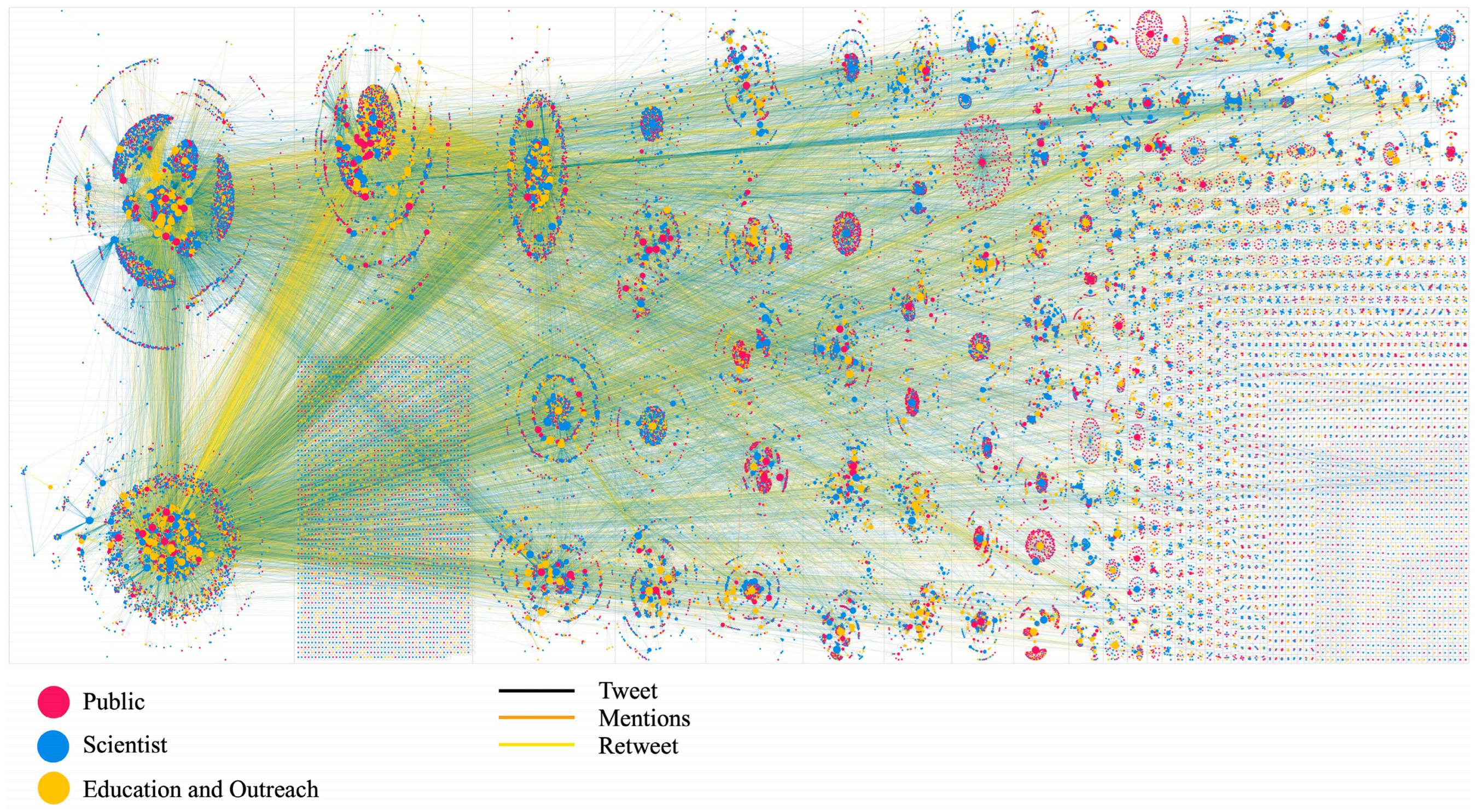
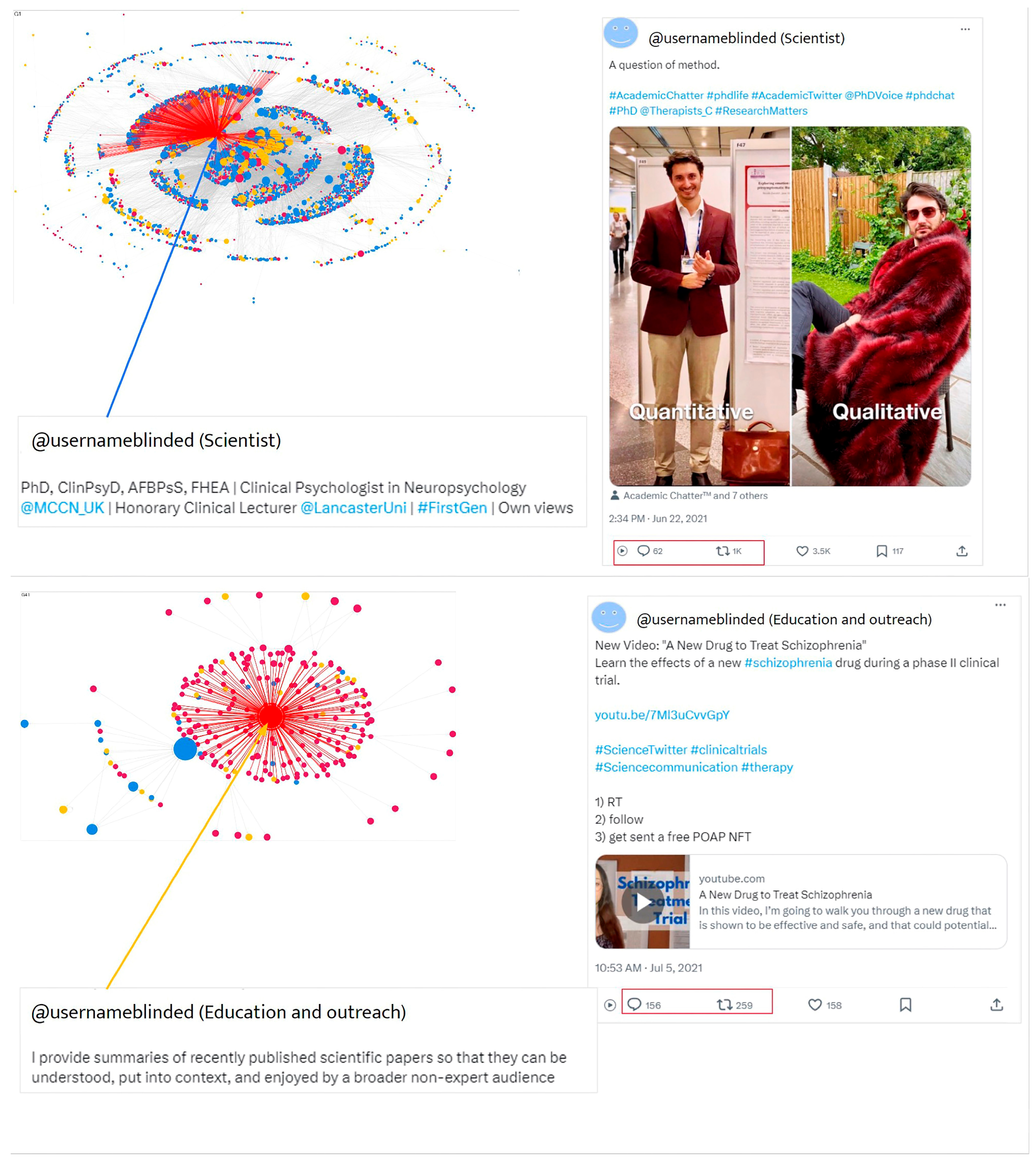
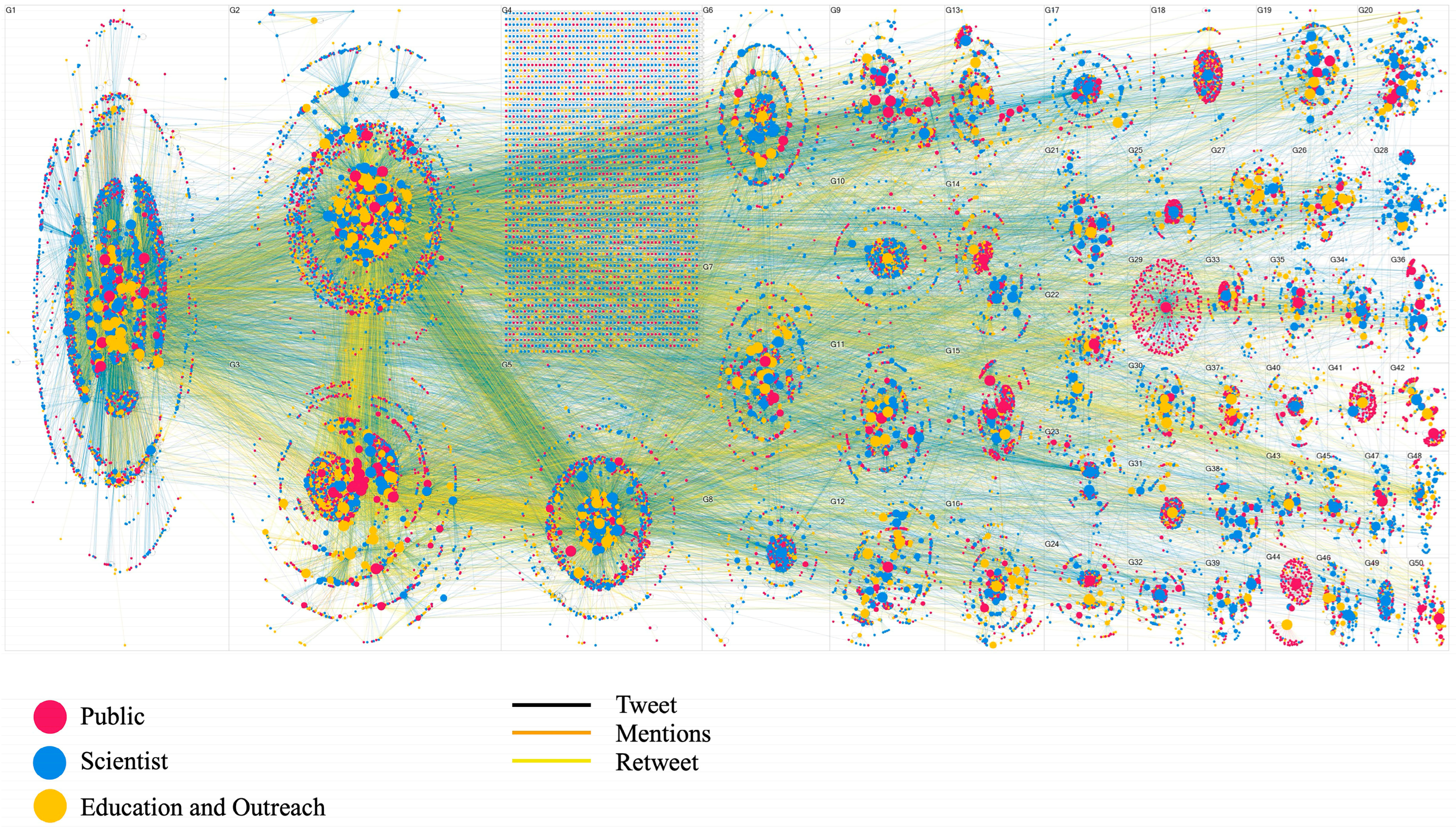
| Category | Definition |
|---|---|
| Education and Outreach | Any entity reference to working in a K-12 setting; as a teacher, lecturer, or in a classroom; in/as a museum or the main focus of the account is education; reference to providing some kind of advocacy or promotion of diversity, equity, and inclusion efforts or providing services to populations that might not otherwise have access to those services (i.e., outreach) |
| Scientist | Any entity that uses a scientific domain to classify themselves, use of “-ist”; students (graduate or undergraduate) using their major; centers, institutes, and research groups are included if they indicate their audience to be other scientists. |
| Public | Any entity that does not meet the definition of Scientist or Education and Outreach. |
| Model | Category | Precision | Recall | F1-Score | Support |
|---|---|---|---|---|---|
| Logistic Regression | Public | 0.85 | 0.53 | 0.65 | 74 |
| Scientist | 0.52 | 0.96 | 0.67 | 81 | |
| Education and Outreach | 1.00 | 0.07 | 0.12 | 45 | |
| Accuracy | N/A | N/A | 0.60 | 200 | |
| Macro avg | 0.79 | 0.52 | 0.48 | 200 | |
| Weighted avg | 0.75 | 0.60 | 0.54 | 200 | |
| Random Forest | Public | 1.00 | 0.19 | 0.32 | 74 |
| Scientist | 0.44 | 1.00 | 0.61 | 81 | |
| Education and Outreach | 0.00 | 0.00 | 0.00 | 45 | |
| Accuracy | N/A | N/A | 0.48 | 200 | |
| Macro avg | 0.48 | 0.40 | 0.31 | 200 | |
| Weighted avg | 0.55 | 0.47 | 0.36 | 200 | |
| Linear Support Vector Machine | Public | 0.74 | 0.82 | 0.78 | 74 |
| Scientist | 0.66 | 0.84 | 0.74 | 81 | |
| Education and Outreach | 0.73 | 0.24 | 0.37 | 45 | |
| Accuracy | N/A | N/A | 0.70 | 200 | |
| Macro avg | 0.71 | 0.64 | 0.63 | 200 | |
| Weighted avg | 0.71 | 0.70 | 0.67 | 200 | |
| Support Vector Machine (SVC) | Public | 1.00 | 0.22 | 0.36 | 74 |
| Scientist | 0.44 | 1.00 | 0.61 | 81 | |
| Education and Outreach | 1.00 | 0.02 | 0.04 | 45 | |
| Accuracy | N/A | N/A | 0.49 | 200 | |
| Macro avg | 0.81 | 0.41 | 0.34 | 200 | |
| Weighted avg | 0.77 | 0.49 | 0.39 | 200 | |
| Multinomial Naive Bayes | Public | 0.70 | 0.69 | 0.69 | 74 |
| Scientist | 0.56 | 0.86 | 0.68 | 81 | |
| Education and Outreach | 1.00 | 0.02 | 0.04 | 45 | |
| Accuracy | N/A | N/A | 0.61 | 200 | |
| Macro avg | 0.75 | 0.53 | 0.47 | 200 | |
| Weighted avg | 0.71 | 0.61 | 0.54 | 200 | |
| Stochastic Gradient Descent (SGD) | Public | 0.78 | 0.64 | 0.70 | 74 |
| Scientist | 0.71 | 0.80 | 0.76 | 81 | |
| Education and Outreach | 0.55 | 0.60 | 0.57 | 45 | |
| Accuracy | N/A | N/A | 0.69 | 200 | |
| Macro avg | 0.68 | 0.68 | 0.68 | 200 | |
| Weighted avg | 0.70 | 0.69 | 0.69 | 200 | |
| Multilayer Perceptron (MLP) | Public | 0.60 | 0.86 | 0.71 | 74 |
| Scientist | 0.73 | 0.65 | 0.69 | 81 | |
| Education and Outreach | 0.76 | 0.36 | 0.48 | 45 | |
| Accuracy | N/A | N/A | 0.64 | 200 | |
| Macro avg | 0.70 | 0.62 | 0.63 | 200 | |
| Weighted avg | 0.69 | 0.67 | 0.65 | 200 |
| Type | Definition | Appearance in Network Diagrams |
|---|---|---|
| Mentions | A user creates a Tweet containing another user’s name, indicated by the “@” character preceding the other user’s name. | A line from the user to another mentioned user. |
| Retweet | A user reposts or forwards a Tweet written by someone else. | A line from the user to another retweeted user. |
| Mentions in retweet | A user is mentioned in the original post when the other user retweeted the Tweet. | A line from the user to the mentioned user. |
| Replies to | A user responds to another user’s Tweet. | A line from the user to the user being replied to. |
| Tweet | A user posts an original message without any other user’s information. | A self-loop. |
| Graph Metric | Value |
|---|---|
| Graph type | Directed |
| Vertices | 53,311 |
| Total edges | 136,136 |
| Number of edge types | 5 |
| Mentions | 17,237 |
| Tweets | 7976 |
| Retweets | 49,134 |
| Mentions in retweet | 59,941 |
| Replies to | 1838 |
| Self-loops | 8210 |
| Reciprocated vertex pair ratio | 0.03613 |
| Reciprocated edge ratio | 0.06975 |
| Connected components | 4700 |
| Single-vertex connected components | 3093 |
| Maximum vertices in a connected component | 44,955 |
| Maximum edges in a connected component | 127,042 |
| Maximum geodesic distance (diameter) | 18 |
| Average geodesic distance | 4.42965 |
| Graph density | 0.00005 |
| Modularity | 0.71383 |
| Groups | 2240 |
| Network Name | Graph |
|---|---|
| Community Clusters | |
| Group 1 | 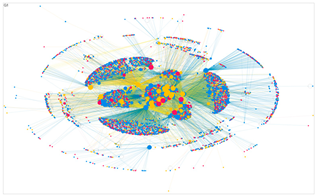 |
| Group 2 | 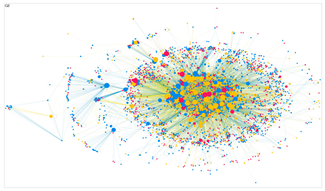 |
| Broadcast network | |
| Group 29 |  |
| Group 41 | 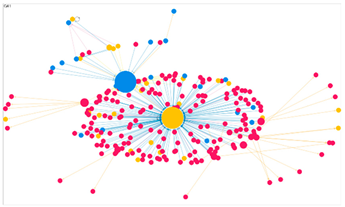 |
| Isolated group | |
| Group 4 |  |
| Rank | Category | In-Degree Centrality | Out-Degree Centrality | Network Group |
|---|---|---|---|---|
| 1 | Education and Outreach | 3417 | 73 | G1 |
| 2 | Scientist | 2984 | 177 | G1 |
| 3 | Education and Outreach | 2175 | 492 | G1 |
| 4 | Scientist | 893 | 1 | G8 |
| 5 | Education and Outreach | 783 | 1 | G10 |
| 6 | Scientist | 702 | 33 | G1 |
| 7 | Scientist | 610 | 4 | G18 |
| 8 | Scientist | 577 | 12 | G1 |
| 9 | Education and Outreach | 575 | 132 | G1 |
| 10 | Scientist | 565 | 4 | G17 |
| Rank | Category | In-Degree Centrality | Out-Degree Centrality | Network Group | Note |
|---|---|---|---|---|---|
| 1 | Public | 2 | 4112 | G5 | bot |
| 2 | Education and Outreach | 1 | 3631 | G2 | |
| 3 | Public | 29 | 3132 | G2 | bot |
| 4 | Scientist | 55 | 1658 | G3 | |
| 5 | Education and Outreach | 35 | 1493 | G3 | |
| 6 | Public | 0 | 508 | G3 | bot |
| 7 | Education and Outreach | 2175 | 492 | G1 | |
| 8 | Public | 14 | 480 | G3 | |
| 9 | Public | 13 | 476 | G3 | bot |
| 10 | Public | 105 | 253 | G14 |
| Rank | Category | Betweenness Centrality | In-Degree Centrality | Out-Degree Centrality | Network Group | Note |
|---|---|---|---|---|---|---|
| 1 | Public | 487,998,649.044 | 2 | 4112 | G5 | bot |
| 2 | Education and Outreach | 380,847,553.172 | 1 | 3631 | G2 | |
| 3 | Education and Outreach | 361,239,568.951 | 3417 | 73 | G1 | |
| 4 | Public | 357,300,566.203 | 29 | 3132 | G2 | bot |
| 5 | Scientist | 254,143,564.522 | 2984 | 177 | G1 | |
| 6 | Education and Outreach | 175,013,982.037 | 2175 | 492 | G1 | |
| 7 | Education and Outreach | 75,409,275.180 | 783 | 1 | G10 | |
| 8 | Scientist | 72,572,046.716 | 893 | 1 | G8 | |
| 9 | Scientist | 55,259,967.550 | 55 | 1658 | G3 | |
| 10 | Scientist | 50,486,043.866 | 610 | 4 | G18 |
| Rank | Category | Closeness Centrality | In-Degree Centrality | Out-Degree Centrality | Network Group | Note |
|---|---|---|---|---|---|---|
| 1 | Public | 0.336 | 2 | 4112 | G5 | bot |
| 2 | Public | 0.328 | 29 | 3132 | G2 | bot |
| 3 | Education and Outreach | 0.325 | 1 | 3631 | G2 | |
| 4 | Education and Outreach | 0.316 | 3417 | 73 | G1 | |
| 5 | Scientist | 0.310 | 2984 | 177 | G1 | |
| 6 | Education and Outreach | 0.304 | 2175 | 492 | G1 | |
| 7 | Scientist | 0.293 | 55 | 1658 | G3 | |
| 8 | Education and Outreach | 0.289 | 35 | 1493 | G3 | |
| 9 | Education and Outreach | 0.287 | 90 | 88 | G1 | |
| 10 | Public | 0.287 | 13 | 476 | G3 | bot |
| Rank | Category | Eigenvector Centrality | In-Degree Centrality | Out-Degree Centrality | Network Group | Note |
|---|---|---|---|---|---|---|
| 1 | Public | 0.401 | 2 | 4112 | G5 | bot |
| 2 | Public | 0.331 | 29 | 3132 | G2 | bot |
| 3 | Education and Outreach | 0.309 | 1 | 3631 | G2 | |
| 4 | Scientist | 0.168 | 55 | 1658 | G3 | |
| 5 | Education and Outreach | 0.152 | 35 | 1493 | G3 | |
| 6 | Education and Outreach | 0.130 | 3417 | 73 | G1 | |
| 7 | Scientist | 0.122 | 2984 | 177 | G1 | |
| 8 | Education and Outreach | 0.106 | 2175 | 492 | G1 | |
| 9 | Public | 0.079 | 14 | 480 | G3 | |
| 10 | Public | 0.072 | 13 | 476 | G3 | bot |
Disclaimer/Publisher’s Note: The statements, opinions and data contained in all publications are solely those of the individual author(s) and contributor(s) and not of MDPI and/or the editor(s). MDPI and/or the editor(s) disclaim responsibility for any injury to people or property resulting from any ideas, methods, instructions or products referred to in the content. |
© 2025 by the authors. Licensee MDPI, Basel, Switzerland. This article is an open access article distributed under the terms and conditions of the Creative Commons Attribution (CC BY) license (https://creativecommons.org/licenses/by/4.0/).
Share and Cite
Zhang, M.; Lundgren, L.; Nguyen, H. An Online Scientific Twitter World: Social Network Analysis of #ScienceTwitter, #SciComm, and #AcademicTwitter. Journal. Media 2025, 6, 159. https://doi.org/10.3390/journalmedia6040159
Zhang M, Lundgren L, Nguyen H. An Online Scientific Twitter World: Social Network Analysis of #ScienceTwitter, #SciComm, and #AcademicTwitter. Journalism and Media. 2025; 6(4):159. https://doi.org/10.3390/journalmedia6040159
Chicago/Turabian StyleZhang, Man, Lisa Lundgren, and Ha Nguyen. 2025. "An Online Scientific Twitter World: Social Network Analysis of #ScienceTwitter, #SciComm, and #AcademicTwitter" Journalism and Media 6, no. 4: 159. https://doi.org/10.3390/journalmedia6040159
APA StyleZhang, M., Lundgren, L., & Nguyen, H. (2025). An Online Scientific Twitter World: Social Network Analysis of #ScienceTwitter, #SciComm, and #AcademicTwitter. Journalism and Media, 6(4), 159. https://doi.org/10.3390/journalmedia6040159






